
State Department Will Spend $25,000 to Engage China’s Surfing Community
January 24, 2022
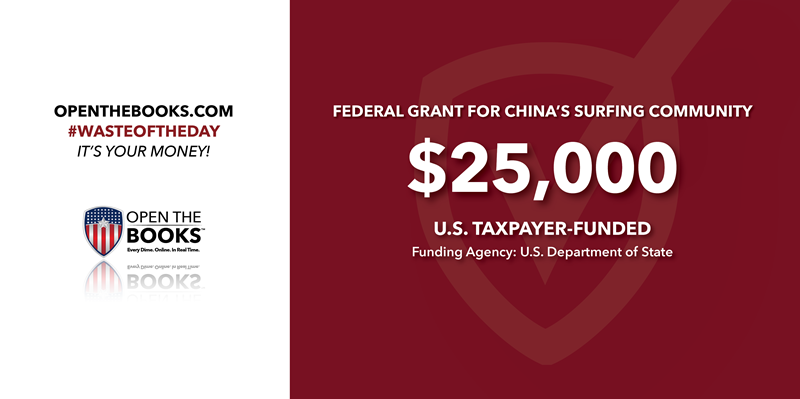
Surf’s up in Guangzhou!
According to a recent grant notice, the United States’ Mission to China is funding a $25,000 grant to “carry out a program to engage Hainan’s surfing community and local environmentally active social media influencers on the topic of climate change and impacts to ocean environments.” It’s your tax dollars at work in the surf of the South China Sea.
That’s right. While Beijing continues its military buildup in the South China Sea, the Biden Administration is making sure surfers enjoy the waves!
The grant describes the ideal program activities to include:
- “one surfing clinic, environmental protection activity and climate discussion led by popular Chinese surfing athletes and including U.S. Consulate staff and local environmentally active social media influencers”;
- “one video product based on the surfing clinic, activity and discussion that includes messaging on the connections between local ocean communities, climate change and the importance of global climate action”;
- “one million post views on multiple Chinese platforms of final video product after being shared by program participants.”
No word yet on if the money must be returned if they only hit 990k views on TikTok – a Chinese owned platform.
Encouraging China, the world’s largest polluter, to talk about their efforts on “global climate action” sounds like a deflection only the Chinese Communist Party could come up with.
The average American pays about $15,000 in federal income taxes, which means all of the income taxes paid by almost two Americans went to this project. Taxpayers should be outraged if their hard-earned tax dollars are going to surfers in California, much less Guangzhou.
Chicago Public Schools Receive $2.8 Billion While Kids Still Stay Home
January 25, 2022
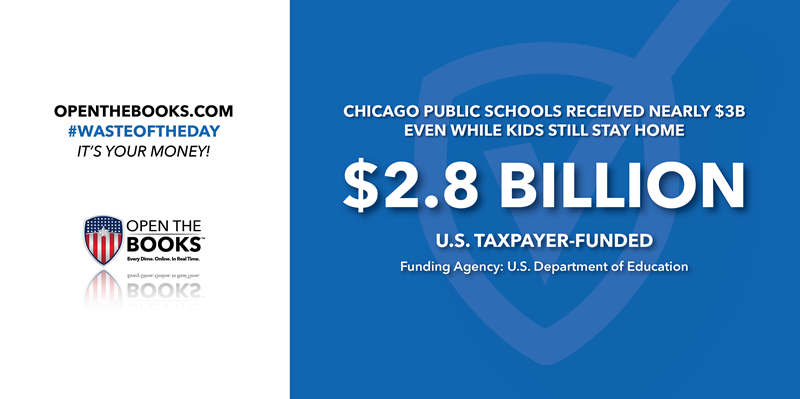
On Tuesday, Jan 4, 2022, the Chicago Teachers Union voted to strike yet again, citing Covid related safety concerns. The students in the Chicago Public School district have frequently been caught in the relentless power struggle between the Chicago Teachers Union and the Chicago Public School system.
In early 2021, CPS demanded that teachers return to classrooms to resume in person instruction, and teachers refused. Now, students’ education is once again in jeopardy.
Teachers claim classrooms still aren’t safe, but the Chicago Public School system received a projected $2.79 billion from the federal government to increase safety in schools, according to projections from Fox Business.
In 2020, Chicago had 20,927 full-time teachers at a total payroll cost of $2.3 billion, according to a response to a Freedom of Information Act request by our organization, OpenTheBooks.com. Our auditors found that the average Chicago teacher earned $108,730 last year—$81,422 in salary and another $27,307 in benefits. Further, teachers are allowed to accumulate up to 244 sick days for use or pension credit. (A full school year runs only 175 days.)
As part of the CARES Act in March of 2020, Congress authorized a grant program called Elementary and Secondary School Emergency Relief (ESSER) funding. There have since been three rounds of ESSER funding, and it’s intended to be used on safety measures like masks, personal protective equipment, testing, and classroom modifications to allow for social distancing.
Some funds were also allocated for the purpose of helping kids catch up on learning after pandemic setback. According to the size of CPS system, Fox Business calculated that this funding would amount to $2.79 billion.
For its part, the City of Chicago has used this money to invest in the safety of public schools. For example, they spent $8.5 million on 20,000 surgical quality HEPA air purifiers in every classroom. They also evaluated and improved ventilation systems in every school, and increased cleaning and disinfection procedures.
However, all of this hasn’t been enough for the teachers’ union, even after demanding to be first in line to receive the Covid vaccine. Two years and billions of dollars later, students are still suffering from remote learning while teachers continue to get paid without having to show up in person for work.
San Diego Blue Line Trolley Extension Costs $2.2 Billion, Double the National Average
January 26, 2022
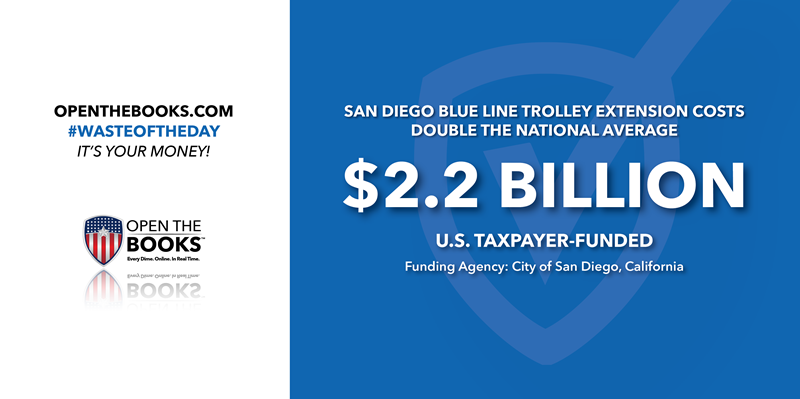
On November 21, 2021, the city of San Diego opened its new Blue Line Trolley extension. The five-year-long project added eleven miles of track and created nine new stations, including stops at UC San Diego and the Veterans Affairs Medical Center. The San Diego Metropolitan Transit Center is touting it as a major success. There’s just one problem: according to a UC Berkeley report, it cost double the national average to build.
Researchers called it “a case study in how not to build rail."
The San Diego Union Tribune reported that “San Diego’s nearly $2.2-billion Blue Line trolley extension between Old Town and University City cost taxpayers double the national average per mile for light-rail projects,” citing the study from UC Berkeley. Despite the price tag, experts said to the Union Tribune that the project was “well executed."
What went wrong? Ethan Elkind, a coauthor of the Berkeley report, blamed opposition by towns and local residents for the delays and extra expenditures.
Elkind concedes that “I don’t think we need a model like China where they don’t respect individual or property rights,” but still argues “at some point, we need to empower transit leaders to make decisions for the good of the region and not always give in to local demands along the route.” In other words, the solution is to give more power to the government that paid double the average cost for this project.
As bad as the overspending is, the worst part is that the project actually finished on budget. That’s right, the government had planned to spend double the national average on this project.
When government is spending your money, the amount of overspending and mismanagement has no limit.
Throwback Thursday: U.S. Spent $112,000 to Study If Different Personalities Prefer Different Foods
January 27, 2022
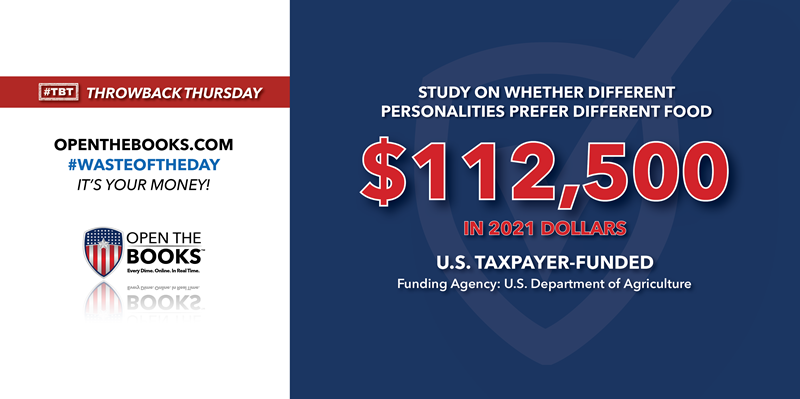
Throwback Thursday!
We’ve all seen those clickbait quizzes offering to decipher what type of personality we have based on our favorite foods. A few of us may have even taken them, but nobody actually believes preferring pizza over pasta has any meaningful interpretation for our personality.
Nobody, except some scientists in 1982, to whom the government paid $40,000 to conduct scientific research on the matter. Today, adjusted for inflation, the government spent the equivalent of $112,500 on the study.
Sen. William Proxmire (D-WI) highlighted this as his “Golden Fleece Award” for the month of January 1982. The U.S. Department of Agriculture spent $40,000 on a yearlong study called “Food Preferences and Social Identity” to test the claim that people with a certain personality prefer certain types of food.
Sen. Proxmire had the right response when said in a press release, “SO WHAT? Who cares what it means whether you eat carrots or caviar? Here’s a $40,000 study calculated to make the American taxpayer eat his heart out.”
The study apparently broke in Psychology Today magazine, in an article titled "Profiles in Eating – Sexy Vegetarians and other Diet Based Social Stereotypes."
So, what did our tax dollars find? The study found that Vegetarians like “intellectual tasks, crafts, and want a good education.” Gourmet lovers “want spouses but few children, and like to mix it up on the tennis court.” Fast food eaters are “supposedly antidrug, patriotic, conservative, and interested in doing extra hard work on the job” and “health food nuts” are “the laid back folks among us.”
Of course, no private institution would fund this sort of research. Lucky for you, your government did.
U.S. Spent $562.4 Billion on Interest Payments in 2021
January 28, 2022
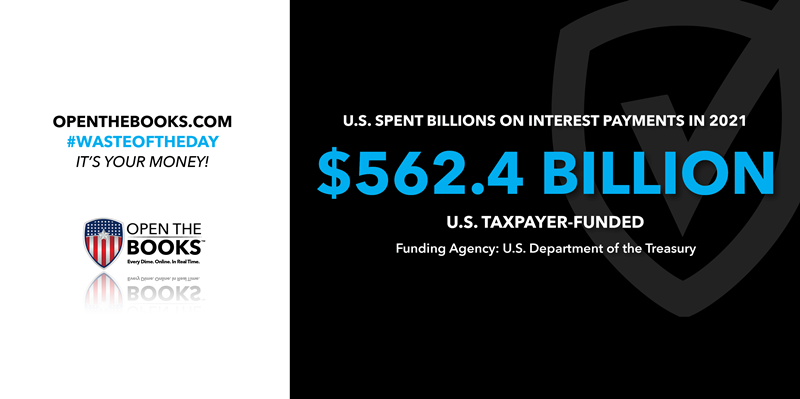
According to the United States Treasury, the United States spent $52.4 billion in Fiscal Year 2021 on interest payments alone. This money isn’t going towards paying off our current debt obligations, which currently stand at over $29 trillion, this just covers the cost of borrowing the money.
In the last two fiscal years, the U.S. spent nearly $1.1 trillion to pay interest on our national debt.
The U.S. hasn’t always held an insurmountable amount of debt. In fact, in 1835, President Andrew Jackson paid off the US national debt completely.
But in the modern era, America’s perpetual deficit spending since 2001 (the last year the U.S. brought in more money than it spent) has gone from $5.8 trillion at the beginning of the George W. Bush administration to $29 trillion (2021).
President Obama and President Trump both contributed to the debt, with Obama adding about $9 trillion in eight years, and Trump adding approximately the same in four years.
Where does the U.S. go from here?
Sen. Rand Paul (R-Ky.) proposes a very reasonable a “penny plan,” where the U.S. could balance its budget (which means that we’re not adding more debt, not that were reducing our current debt) in five years by cutting 1% of all spending from the federal budget.
Paul first proposed the plan in 2015. Now, it would take a “five penny plan” to reduce spending by 5% to balance the budget in five-years.
While Congress continues to spend, our interest payments will continue to compound and grow. Economist Brian Riedl estimates that by 2051, the U.S. could be paying anywhere from $296 billion to $5.7 trillion just on interest payments. He also projects our debt could be anywhere from 130% to 357% of our gross domestic product by 2051.
Tax and spend policies by Republicans and Democrats need to be vigorously opposed before it’s too late.
The national debt needs fixing, and fast.
The #WasteOfTheDay is presented by the forensic auditors at OpenTheBooks.com.